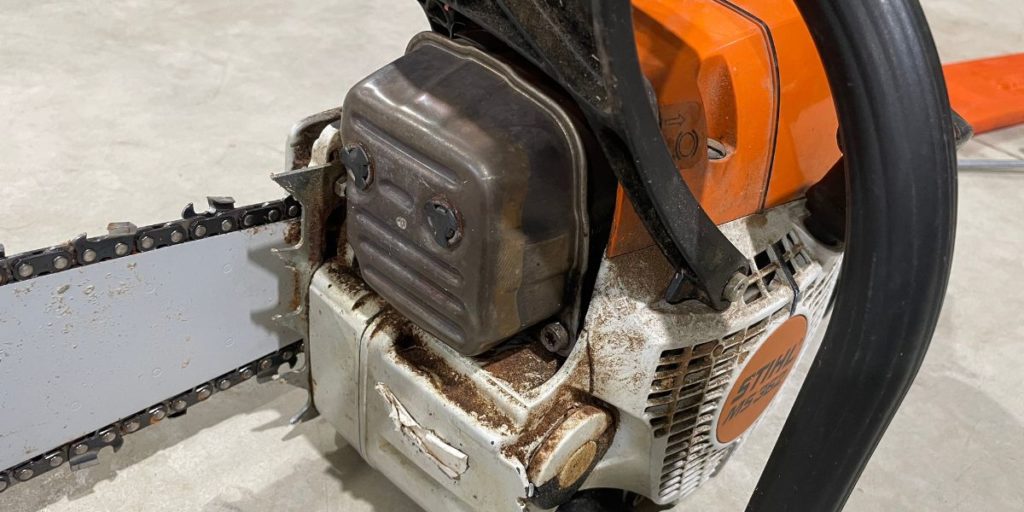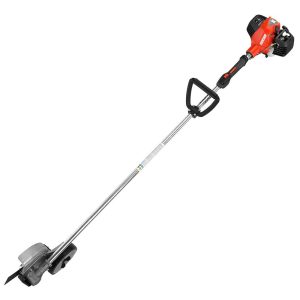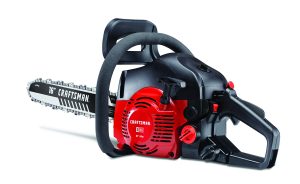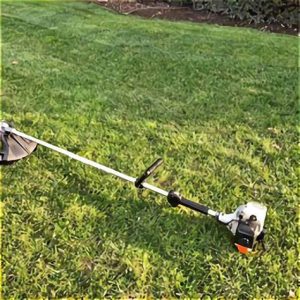7 Reasons Why a Chainsaw Only Runs With the Choke On: Solved It!
It’s infuriating to have to keep the chainsaw on half choke or higher due to erratic performance. The issue must be identified and fixed if the chainsaw is to continue operating at peak efficiency.
If the chainsaw’s engine is getting too much air or not enough fuel, only then will the chainsaw operate with the choke engaged. Possible causes include a clogged fuel filter or vent in the gas tank, a damaged or kinked fuel line, a dirty carburetor, a faulty carburetor gasket, or an improperly adjusted carburetor.
Be sure to read and understand the operator’s manual’s safety instructions before attempting any repairs. The spark plug wire must be disconnected.

Before diagnosing, repairing, or operating the equipment, be sure to read and follow all of the safety instructions that came with it. If you are unsure of how to proceed or if you lack the necessary knowledge or experience, or if your health prevents you from doing so, you should seek the assistance of a professional.
Table of Contents
Reasons Why a Chainsaw Runs Only With the Choke On
Old Fuel in a Chainsaw
Using stale fuel in a chainsaw can damage the engine. This is because ethanol, a common additive to modern gasoline, acts as a moisture magnet.
Damage to the carburetor and clogging of the fuel supply can result from the combination of water and ethanol. When possible, use fuel with no more than a 10% ethanol content to avoid issues brought on by stale gas.
For the sake of the chainsaw’s diminutive engine, a lower ethanol content is preferable. If you want to get the most out of your fuel, you should buy it and use it within 30 days. If there is a possibility that the fuel will not be used within this time frame, a fuel stabilizer can be added to extend its shelf life.
Most chainsaws have 2-cycle engines, which run on a combination of gasoline and oil. One can find a fuel stabilizer in some 2-cycle engine oils. Depending on the oil’s manufacturer, they can extend the fuel’s shelf life by anywhere from 30 days to 2 years.
Sea Foam Motor Treatment, also known as STA-BIL, can be added to the fuel/oil mixture of a two-cycle chainsaw or to gasoline in a four-cycle chainsaw. Fuel stability and moisture removal are achieved by both of these approaches.
If you discover that the gas in your saw has been sitting for a long time, you should empty the tank and refill it with fresh fuel and a stabilizer.
After adding stabilizer to new fuel in the tank, the chainsaw needs to be run for several minutes to distribute the treated fuel throughout the machine.
Fuel for a Two-Cycle Chainsaw Engine
- Depending on the manufacturer, a gas and oil mixture in the ratio of 50:1 or 40:1 is required. For a list of manufacturers and their fuel requirements, see the chart in this guide.
- Use gasoline with an octane rating of at least 89.
- Use only gasoline with less than 10% ethanol content.
- Add a 2-cycle premium oil. This is not the same as regular engine oil.
- Use the fuel within 30 days.
- When you are unable to consume fuel quickly, add a fuel stabilizer to fresh gasoline to make it last a little longer.
- Keep fuel in a dry place.
Fuel for a Four-Cycle Chainsaw Engine
- Gasoline with a minimum octane rating of 89 and a maximum ethanol content of 10% is required. Do not combine with oil.
- Use the fuel within 30 days.
- When you are unable to consume fuel quickly, add a fuel stabilizer to fresh gasoline to make it last a little longer.
- Keep fuel in a dry place.
Fuel Filter Plugged in a ChainsawThe fuel filter cleans the fuel before it goes into the carburetor. This will prevent dirt and other debris from entering the engine and fuel system.
The fuel flow to your engine can be impeded if the filter isn’t regularly replaced. The decreased fuel flow may necessitate a reduction in air intake, which can be achieved by running with the choke partially or half-open.
A fuel filter, typically cylindrical in shape, is located on the fuel line inside the fuel tank. Remove any debris from the area around the fuel tank’s cap before installing a new fuel filter.
Remove the fuel filter from the tank with the help of a clean, bent wire. Maintain firm grip on the fuel line as you take out the filter. Changing out the fuel filter and replacing it with a new one. Reconnect the fuel tank cap.
Chainsaw Fuel Line Punctured or Clogged
If the fuel line becomes clogged, preventing a steady supply of fuel, you may once again need to engage the choke. It could also be the result of a puncture in the fuel line, which would let air into the fuel system.
Checking the fuel lines is a must. Check for a blockage that could restrict fuel flow or a puncture that could let air into the system.
If either of these issues is discovered, the fuel line must be replaced. You can try to unclog the fuel line rather than immediately replacing it by cleaning it thoroughly. If the chainsaw’s line becomes clogged, you can remove it, spray it with carburetor cleaner, and then use compressed air to clear the line.
Plugged Chainsaw Fuel Vent
Chainsaws have a tiny circular vent that lets air into the tank at atmospheric pressure to maintain a constant fuel pressure. You may find that the fuel tank of your chainsaw vents through the fuel cap instead of the circular vent.
Lack of adequate venting in a fuel tank causes internal pressure to build, creating a vacuum that impedes the fuel’s ability to drain. The fuel flow to the carburetor will be cut back as a result.
Using a vacuum tester, you can determine if the vent in your fuel tank is blocked. Place the saw on a flat surface, turn it on, and then release the choke if you don’t have a vacuum tester. Loosen the fuel cap to let air into the tank if it starts running poorly.
If the chainsaw starts and runs normally after you let air into the tank, the fuel tank vent may be clogged. You can keep operating the saw until you notice it running slowly or shutting down, at which point you can loosen the cap and verify the issue.
If you find that loosening the cap and running the saw without the choke eliminates the problem, you should replace the vent.
Bad Carburetor Gasket on a Chainsaw
The gasket behind the carburetor can dry out and let air into the system, which is why it’s important to keep it in good condition. Leaning out means there is more air than fuel in the cylinder, which will cause your chainsaw to sputter and stall.
Carefully disconnect the carburetor’s linkages and bolts to gain access to the part. Take out the gasket and carburetor. Change the gasket on the carburetor.
You need to make sure the carburetor is working properly before you put it in. When you take the chainsaw apart, you might as well clean it.
Chainsaw Carburetor Clogged
The carburetor is the part of your chainsaw that controls the ratio of fuel to air during combustion. The accumulation of varnish and deposits in the carburetor can disrupt its ability to do so.
You should be able to clean the carburetor on your own if you have a passing familiarity with mechanics. The carburetor needs to be disassembled and cleaned with carburetor cleaner to get rid of the residue left behind by the old fuel.
After cleaning, if the carburetor still doesn’t work, you may need to have it rebuilt or get a new one.
Chainsaw Carburetor Requires Adjustment
It’s possible that adjusting the carburetor’s jets would be necessary to achieve the desired variation in engine speed between idle and wide open throttle. It could be making the engine run too lean and requiring the use of the choke.
You can fine-tune the carburetor by turning its adjustment screws. There should be three knobs on a chainsaw: one for low speed, one for high speed, and one for idle.
In order to find the “sweet spot” where the chainsaw runs smoothly and quickly, you should let it idle and turn the low-speed screw clockwise and counterclockwise.
The next step is to fine-tune the high-speed screw so that full throttle results in a consistent RPM. Avoid letting the RPMs get too high, as this could cause engine failure. If the chain is jiggling while it’s not doing anything, you may need to tweak the idle screw.
The owner may only be able to make so many changes to the carburetor on some brands of chainsaws. Bring your chainsaw into your local chainsaw dealer if you continue to have carburetor issues or if your model of Husqvarna does not permit you to make the carburetor adjustments.
It’s possible that only your dealer has access to the specialized equipment needed to make the required modifications.







